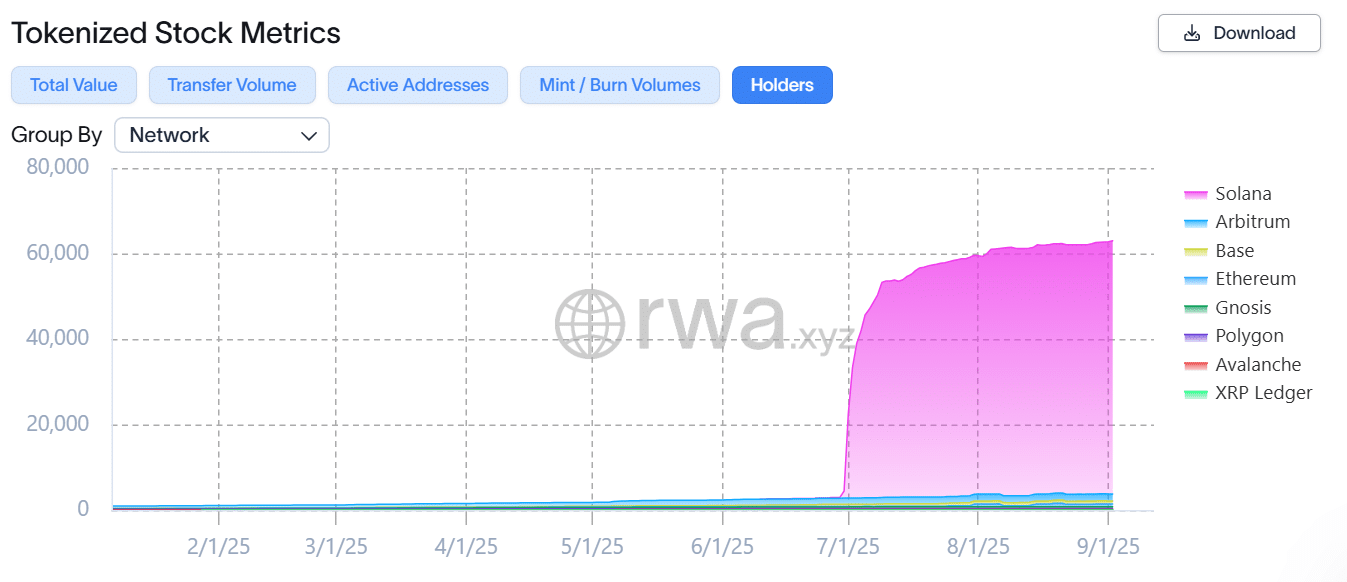| COINOTAG recommends • Exchange signup |
| 💹 Trade with pro tools |
| Fast execution, robust charts, clean risk controls. |
| 👉 Open account → |
| COINOTAG recommends • Exchange signup |
| 🚀 Smooth orders, clear control |
| Advanced order types and market depth in one view. |
| 👉 Create account → |
| COINOTAG recommends • Exchange signup |
| 📈 Clarity in volatile markets |
| Plan entries & exits, manage positions with discipline. |
| 👉 Sign up → |
| COINOTAG recommends • Exchange signup |
| ⚡ Speed, depth, reliability |
| Execute confidently when timing matters. |
| 👉 Open account → |
| COINOTAG recommends • Exchange signup |
| 🧭 A focused workflow for traders |
| Alerts, watchlists, and a repeatable process. |
| 👉 Get started → |
| COINOTAG recommends • Exchange signup |
| ✅ Data‑driven decisions |
| Focus on process—not noise. |
| 👉 Sign up → |
Tokenized stocks are on the rise: Coinbase announced Mag7 + Crypto Equity Index Futures to combine top US tech stocks with major crypto ETFs, expanding tokenized-stock access across DeFi and centralized venues.
-
Coinbase launches combined equity‑crypto index futures
-
Solana leads on-chain adoption with the most tokenized stockholders; Ethereum and L2s follow.
-
xStocks crossed $300M volume in one month; total on-chain trading reached $630M at press time.
Meta description: Tokenized stocks surge as Coinbase launches Mag7 + Crypto Equity Index Futures combining top tech stocks and crypto ETFs — read what this means for on‑chain markets.
| COINOTAG recommends • Professional traders group |
| 💎 Join a professional trading community |
| Work with senior traders, research‑backed setups, and risk‑first frameworks. |
| 👉 Join the group → |
| COINOTAG recommends • Professional traders group |
| 📊 Transparent performance, real process |
| Spot strategies with documented months of triple‑digit runs during strong trends; futures plans use defined R:R and sizing. |
| 👉 Get access → |
| COINOTAG recommends • Professional traders group |
| 🧭 Research → Plan → Execute |
| Daily levels, watchlists, and post‑trade reviews to build consistency. |
| 👉 Join now → |
| COINOTAG recommends • Professional traders group |
| 🛡️ Risk comes first |
| Sizing methods, invalidation rules, and R‑multiples baked into every plan. |
| 👉 Start today → |
| COINOTAG recommends • Professional traders group |
| 🧠 Learn the “why” behind each trade |
| Live breakdowns, playbooks, and framework‑first education. |
| 👉 Join the group → |
| COINOTAG recommends • Professional traders group |
| 🚀 Insider • APEX • INNER CIRCLE |
| Choose the depth you need—tools, coaching, and member rooms. |
| 👉 Explore tiers → |
What are tokenized stocks and why is Coinbase launching Mag7 + Crypto Equity Index Futures?
Tokenized stocks are blockchain representations of traditional equities that enable fractional, 24/7 trading on crypto-native venues. Coinbase’s Mag7 + Crypto Equity Index Futures bundle top US tech stocks with major crypto ETFs to offer thematic exposure and bridge centralized markets with on‑chain liquidity.
How will the Mag7 + Crypto Equity Index Futures work?
Coinbase says the index will combine the top seven tech stocks (including Apple, Nvidia, Tesla) with crypto ETFs tracking BTC and ETH plus Coinbase’s COIN. The product aims to provide thematic exposure and deeper liquidity across equities and crypto in a single futures contract.
| COINOTAG recommends • Exchange signup |
| 📈 Clear interface, precise orders |
| Sharp entries & exits with actionable alerts. |
| 👉 Create free account → |
| COINOTAG recommends • Exchange signup |
| 🧠 Smarter tools. Better decisions. |
| Depth analytics and risk features in one view. |
| 👉 Sign up → |
| COINOTAG recommends • Exchange signup |
| 🎯 Take control of entries & exits |
| Set alerts, define stops, execute consistently. |
| 👉 Open account → |
| COINOTAG recommends • Exchange signup |
| 🛠️ From idea to execution |
| Turn setups into plans with practical order types. |
| 👉 Join now → |
| COINOTAG recommends • Exchange signup |
| 📋 Trade your plan |
| Watchlists and routing that support focus. |
| 👉 Get started → |
| COINOTAG recommends • Exchange signup |
| 📊 Precision without the noise |
| Data‑first workflows for active traders. |
| 👉 Sign up → |
- Index composition: MAG7 tech stocks + BTC/ETH ETFs + COIN.
- Product design: cash‑settled futures offering combined exposure.
- Distribution: Coinbase plans both single‑stock tokenized offerings and the multi‑asset equity‑crypto index.
Why is Solana leading on‑chain tokenized stock adoption?
Solana’s low fees and high throughput have driven rapid onboarding for tokenized stock projects. Early entrants like xStocks launched on Solana and hit $300M in volume within a month, while on‑chain holders concentrated on Solana (~59k addresses) suggest strong network product‑market fit.
| COINOTAG recommends • Traders club |
| ⚡ Futures with discipline |
| Defined R:R, pre‑set invalidation, execution checklists. |
| 👉 Join the club → |
| COINOTAG recommends • Traders club |
| 🎯 Spot strategies that compound |
| Momentum & accumulation frameworks managed with clear risk. |
| 👉 Get access → |
| COINOTAG recommends • Traders club |
| 🏛️ APEX tier for serious traders |
| Deep dives, analyst Q&A, and accountability sprints. |
| 👉 Explore APEX → |
| COINOTAG recommends • Traders club |
| 📈 Real‑time market structure |
| Key levels, liquidity zones, and actionable context. |
| 👉 Join now → |
| COINOTAG recommends • Traders club |
| 🔔 Smart alerts, not noise |
| Context‑rich notifications tied to plans and risk—never hype. |
| 👉 Get access → |
| COINOTAG recommends • Traders club |
| 🤝 Peer review & coaching |
| Hands‑on feedback that sharpens execution and risk control. |
| 👉 Join the club → |
xStocks tracks 60+ equities and indices, including Amazon and gold; at press time the suite reported $630M total trading volume, underscoring demand for single‑asset on‑chain stock products.


Source: RWA
| COINOTAG recommends • Exchange signup |
| 📈 Clear control for futures |
| Sizing, stops, and scenario planning tools. |
| 👉 Open futures account → |
| COINOTAG recommends • Exchange signup |
| 🧩 Structure your futures trades |
| Define entries & exits with advanced orders. |
| 👉 Sign up → |
| COINOTAG recommends • Exchange signup |
| 🛡️ Control volatility |
| Automate alerts and manage positions with discipline. |
| 👉 Get started → |
| COINOTAG recommends • Exchange signup |
| ⚙️ Execution you can rely on |
| Fast routing and meaningful depth insights. |
| 👉 Create account → |
| COINOTAG recommends • Exchange signup |
| 📒 Plan. Execute. Review. |
| Frameworks for consistent decision‑making. |
| 👉 Join now → |
| COINOTAG recommends • Exchange signup |
| 🧩 Choose clarity over complexity |
| Actionable, pro‑grade tools—no fluff. |
| 👉 Open account → |
What regulatory responses are emerging to tokenized stocks?
Regulators and industry bodies are scrutinizing tokenized stocks. The World Federation of Exchanges has urged Senate-level regulation, labeling tokenized instruments as “mimics” without the same shareholder rights as traditional equities.
The U.S. Securities and Exchange Commission’s Project Crypto discussions and public statements from exchanges are being cited in market commentary as drivers of regulatory clarity in this space.
| COINOTAG recommends • Members‑only research |
| 📌 Curated setups, clearly explained |
| Entry, invalidation, targets, and R:R defined before execution. |
| 👉 Get access → |
| COINOTAG recommends • Members‑only research |
| 🧠 Data‑led decision making |
| Technical + flow + context synthesized into actionable plans. |
| 👉 Join now → |
| COINOTAG recommends • Members‑only research |
| 🧱 Consistency over hype |
| Repeatable rules, realistic expectations, and a calmer mindset. |
| 👉 Get access → |
| COINOTAG recommends • Members‑only research |
| 🕒 Patience is an edge |
| Wait for confirmation and manage risk with checklists. |
| 👉 Join now → |
| COINOTAG recommends • Members‑only research |
| 💼 Professional mentorship |
| Guidance from seasoned traders and structured feedback loops. |
| 👉 Get access → |
| COINOTAG recommends • Members‑only research |
| 🧮 Track • Review • Improve |
| Documented PnL tracking and post‑mortems to accelerate learning. |
| 👉 Join now → |
Frequently Asked Questions
How are tokenized stocks different from traditional shares?
Tokenized stocks are digital tokens that mirror the economic exposure of an underlying share without the same legal shareholder rights; custody and settlement can occur on blockchain platforms rather than traditional registries.
| COINOTAG recommends • Exchange signup |
| 🎯 Focus on process over noise |
| Plan trades, size positions, execute consistently. |
| 👉 Sign up → |
| COINOTAG recommends • Exchange signup |
| 🛠️ Simplify execution |
| Keep decisions clear with practical controls. |
| 👉 Get started → |
| COINOTAG recommends • Exchange signup |
| 📊 Make data your edge |
| Use depth and alerts to avoid guesswork. |
| 👉 Open account → |
| COINOTAG recommends • Exchange signup |
| 🧭 Be prepared, not reactive |
| Turn setups into rules before you trade. |
| 👉 Create account → |
| COINOTAG recommends • Exchange signup |
| ✍️ Plan first, then act |
| Entries, exits, and reviews that fit your routine. |
| 👉 Join now → |
| COINOTAG recommends • Exchange signup |
| 🧩 Consistency beats intensity |
| Small, repeatable steps win the long run. |
| 👉 Sign up → |
Can tokenized stocks be traded 24/7?
Yes. Tokenized stock products traded on crypto venues offer near‑continuous trading windows, unlike traditional exchanges that follow fixed trading hours.
Are tokenized stocks regulated the same as equities?
Not uniformly. Regulators and exchange bodies, including the World Federation of Exchanges and the U.S. SEC (Project Crypto discussions), are evaluating frameworks; legal treatment varies by jurisdiction.
| COINOTAG recommends • Premium trading community |
| 🏛️ WAGMI CAPITAL — Premium Trading Community |
| Strategic insights, exclusive opportunities, professional support. |
| 👉 Join WAGMI CAPITAL → |
| COINOTAG recommends • Premium trading community |
| 💬 Inner Circle access |
| See members share real‑time PnL and execution notes in chat. |
| 👉 Apply for Inner Circle → |
| COINOTAG recommends • Premium trading community |
| 🧩 Turn theses into trades |
| Reusable templates for entries, risk, and review—end to end. |
| 👉 Join the club → |
| COINOTAG recommends • Premium trading community |
| 💡 Long‑term mindset |
| Patience and discipline over noise; a process that compounds. |
| 👉 Get started → |
| COINOTAG recommends • Premium trading community |
| 📚 Education + execution |
| Courses, playbooks, and live market walkthroughs—learn by doing. |
| 👉 Get access → |
| COINOTAG recommends • Premium trading community |
| 🔒 Members‑only research drops |
| Curated analyses and private briefings—quality over quantity. |
| 👉 Join WAGMI CAPITAL → |
Key Takeaways
- Coinbase expands tokenized offerings: Launches Mag7 + Crypto Equity Index Futures to combine top tech stocks with major crypto ETFs.
- Solana leads early adoption: Most on‑chain stockholders are concentrated on Solana, followed by Ethereum and L2s.
- Regulatory scrutiny increasing: Industry groups and regulators are debating legal treatment; Project Crypto and the World Federation of Exchanges are referenced in market commentary.
Conclusion
Tokenized stocks continue to accelerate, driven by projects like xStocks and new products from major exchanges. Coinbase’s Mag7 + Crypto Equity Index Futures signal growing convergence between equities and crypto markets. Monitor on‑chain volumes, index composition, and regulatory updates as this market evolves.
| COINOTAG recommends • Exchange signup |
| 🧱 Execute with discipline |
| Watchlists, alerts, and flexible order control. |
| 👉 Sign up → |
| COINOTAG recommends • Exchange signup |
| 🧩 Keep your strategy simple |
| Clear rules and repeatable steps. |
| 👉 Open account → |
| COINOTAG recommends • Exchange signup |
| 🧠 Stay objective |
| Let data—not emotion—drive actions. |
| 👉 Get started → |
| COINOTAG recommends • Exchange signup |
| ⏱️ Trade when it makes sense |
| Your plan sets the timing—not the feed. |
| 👉 Join now → |
| COINOTAG recommends • Exchange signup |
| 🌿 A calm plan for busy markets |
| Set size and stops first, then execute. |
| 👉 Create account → |
| COINOTAG recommends • Exchange signup |
| 🧱 Your framework. Your rules. |
| Design entries/exits that fit your routine. |
| 👉 Sign up → |
| COINOTAG recommends • Members‑only research |
| 📌 Curated setups, clearly explained |
| Entry, invalidation, targets, and R:R defined before execution. |
| 👉 Get access → |
| COINOTAG recommends • Members‑only research |
| 🧠 Data‑led decision making |
| Technical + flow + context synthesized into actionable plans. |
| 👉 Join now → |
| COINOTAG recommends • Members‑only research |
| 🧱 Consistency over hype |
| Repeatable rules, realistic expectations, and a calmer mindset. |
| 👉 Get access → |
| COINOTAG recommends • Members‑only research |
| 🕒 Patience is an edge |
| Wait for confirmation and manage risk with checklists. |
| 👉 Join now → |
| COINOTAG recommends • Members‑only research |
| 💼 Professional mentorship |
| Guidance from seasoned traders and structured feedback loops. |
| 👉 Get access → |
| COINOTAG recommends • Members‑only research |
| 🧮 Track • Review • Improve |
| Documented PnL tracking and post‑mortems to accelerate learning. |
| 👉 Join now → |









